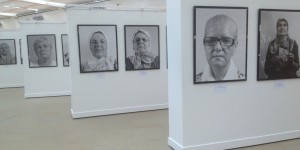Excellencies, Ladies and Gentlemen,
First of all, I want to particularly welcome representatives of the “Women of Srebrenica” and “Mothers of Srebrenica” as well as from many other NGOs in Bosnia and Herzegovina, who have travelled a long way to be here with us. Tonight, we honour you. I would now like to share a moment of silence to commemorate the victims.
The genocide of Srebrenica scarred not only South East Europe, but Europe as a whole. It left innumerable deep wounds. It imposes the moral obligation on us all never to forget.
To commemorate the 20th anniversary of this tragedy, I have invited the photographer Sead Husić to exhibit his works here in the Berlaymont building, at the heart of Europe. This exhibition shows portraits of 40 women of Srebrenica who have lost their loved ones: husbands and sons, fathers and grandfathers, uncles and friends.
Through these striking portraits of grief, we can only start to imagine their loss. We are honouring the victims, showing our deep respect. And we look into a mirror of Europe’s and the world’s failure to protect them.
For the leaders of the European Union, one of the main lessons learnt from the 1990s Balkans wars was not just to engage in reconstruction. More fundamentally, we have been crystal-clear that the future of each country in the region lies in the European Union.
The South East European countries are a genuine part of Europe. Without them, our project is not complete. Their citizens deserve the opportunities and freedoms that characterise our lives in a Union of over 500 million people. It is a Union which remains first and foremost a peace project.
We expect the strongest commitment from all countries in the region to focus their work on their European path. This is the best way to reconcile with the tragedies of the past, and to ensure that such crimes never happen again.
Reconciliation remains a fundamental objective for all of us. But reconciliation passes through truth and justice. Bringing war criminals to trial and in so doing bringing justice to the victims and their families has been supported by the European Union throughout the last two decades.
We have, for instance, supported the work of the International Commission on Missing Persons. We are working closely with civil society to help the victims. We have strongly supported the work of the International Criminal Tribunal for the former Yugoslavia (ICTY), including.by conditioning progress of the countries towards the EU upon their full cooperation with the ICTY.
Last but not least, the EU particularly focusses on helping accelerate the work of domestic Courts and Prosecutors to clear the war crimes backlog. Because justice delayed is justice denied.
But we all know that while there is no reconciliation without justice; justice alone does not bring about reconciliation. Reconciliation must gradually grow within societies, between peoples and nations. Reconciliation cannot be imposed from outside. It must be achieved in the countries and in the region. It is not a given. It requires continuous efforts on everyone’s part.
What matters now is to continue rebuilding the trust between the peoples in Bosnia and Herzegovina and in the whole region. I therefore wish that this commemoration, which is primarily about honouring the victims of the genocide, will at the same time act as an impetus for broader reconciliation.
Ladies and gentlemen,
Before we can have a closer look at the exhibition I would like to invite Sead Husić, to share with us his thoughts about the concept of the exhibition and his portraits. Following Sead’s intervention, a representative of the association “Women of Srebrenica” from Tuzla will take the floor.
Thank you for your attention.



